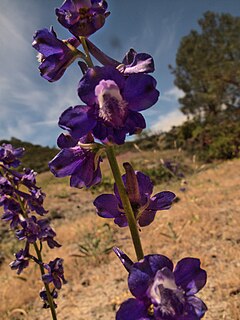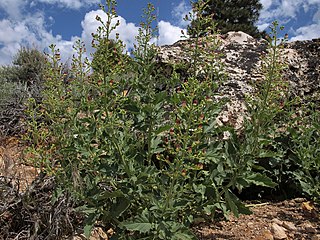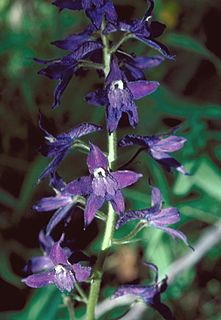
Delphinium andersonii is a species of perennial larkspur known as Anderson's larkspur. This wildflower is native to western North America, where it can be found in the Great Basin and the Sierra Nevada.

Delphinium californicum is a species of larkspur known as California larkspur. This wildflower is endemic to California, where it is a resident of the chaparral slopes of the San Francisco Bay Area and Central Coast.

Delphinium depauperatum is a species of larkspur known by the common names slim larkspur and dwarf larkspur. This wildflower is native to western North America where it is found in mountain meadows. It grows from a short root and erects a stem usually under 40 centimeters in maximum height. The small leaves are divided into lobes and are usually located about the base of the plant. Toward the top of the stem are flowers on long pedicels, with usually not more than 20 flowers per plant. The flowers generally have deep dark blue sepals which are flat and extended to the sides, and petals which are mainly the same color except for the top two, which may be lighter blue to white. The spur is between one and two centimeters long.
Delphinium gracilentum is a species of larkspur known by the common name pine forest larkspur. It is endemic to California, where it grows throughout the Sierra Nevada. This wildflower is usually around half a meter in maximum height, with leaves growing from the lowest third of the stem. The leaves usually have five lobes. The upper part of the stem is occupied by widely spaced flowers, which each grow at the end of a pedicel a few centimeters long. The flower color may be any shade of blue, or occasionally white or pinkish. The sepals often curl backwards. The spur is usually between 1 and 1.5 centimeters long.

Delphinium nuttallianum is a species of larkspur known by the common names twolobe larkspur, Nuttall's larkspur, and common larkspur. It is widely distributed across western North America from California to Alberta, including mountain meadows and the majority of the sagebrush steppe, except very dry areas.

Delphinium trolliifolium is a species of larkspur known by the common names poison delphinium, cow poison, and Columbian larkspur. It is native to Washington, Oregon, and northern California. This wildflower reaches one half to just over one meter in height. It has large, shiny, deeply lobed leaves. The top half of the stem is an inflorescence of widely spaced flowers on long pedicels, the longest over nine centimeters long. The flowers are usually deep brilliant blue. The upper two petals may be milky white. The spur exceeds two centimeters in length in the largest of the flowers. This plant is toxic as suggested by the common names, but most larkspur species are toxic to some degree.

Hulsea algida is a species of flowering plant in the daisy family, known by the common name Pacific hulsea or alpine gold.

Delphinium bicolour is a species of larkspur known as little larkspur and low larkspur. It is native to northwestern North America from British Columbia to South Dakota, where it grows in mountain forests and foothill scrub and prairie. This is a perennial herb growing from a thickly branching root system. It produces solitary stems to 40 centimetres (16 in) in height and green with reddish bases. Most of the leaves are low on the stem and grow on short petioles. They are several centimeters long with many rounded lobes. The small inflorescence holds a few large flowers per stem. The flower has dark purple-blue sepals each about 2 centimeters long and a spur of 1 to 2 centimeters. The plant is poisonous to cattle, less so to sheep, and it is occasionally eaten by various species of wild cervids.
Delphinium inopinum is a species of larkspur known by the common name unexpected larkspur. It is endemic to the Sierra Nevada of California, where it is known mostly from rocky areas in open temperate coniferous forest habitat.

Delphinium stachydeum is a species of larkspur known by the common name spiked larkspur. It is native to the Pacific Northwest and Great Basin of the United States, where it grows in sagebrush scrub and along the edges of mountain forest habitat where it meets prairie and plateau. It is a perennial herb producing at least one erect, slightly hairy stem generally exceeding a meter in height. The multilobed leaves are located mainly on the lower half of the stem except for the area just above ground level. The inflorescence is a branching array of usually more than 30 flowers, each held on a long pedicel. The flower has bright blue sepals around a centimeter long fringed with hairs and surrounding smaller, paler petals. The spur at the back of the flower is just over a centimeter in length.

Delphinium uliginosum is a species of larkspur known by the common names swamp larkspur and bog larkspur. It is endemic to California, where it is known from very localized populations in the Inner North Coast Ranges. It grows in chaparral, grassland, and other habitat in the hills, generally on serpentine soils. This is a perennial herb producing a hairless, erect stem up to 70 centimeters tall. It can be identified by its leaves, which are fan-shaped, a characteristic unique among the larkspurs, which generally have palmate leaves with narrow, fingerlike lobes. The inflorescence bears up to 45 flowers, each on an upright pedicel which may exceed 10 centimeters long. The flower is blue with the longest sepals 1.4 centimeters long and a spur about the same length. The fruit is one or two centimeters long.
Delphinium umbraculorum is a species of larkspur known by the common name umbrella larkspur. However, its epithet does not denote an umbrella. Instead, it describes the habitat of this plant, usually shady and cool places. It is often confused with D. parryii which has similar flowers and D. patens which has similar stems and leaves. It is endemic to California, where it grows in the woodlands of the coastal mountain ranges from Monterey to Ventura Counties. It is a perennial herb producing an erect stem 40 to about 80 centimeters tall. The hairless leaves are located at the base of the plant and along the stem as well. The inflorescence bears several flowers with reflexed dark blue sepals and a spur over a centimeter long. The fruit is between 1 and 2 centimeters long.
Orochaenactis is a monotypic genus of flowering plants in the daisy family containing the single species Orochaenactis thysanocarpha, which is known by the common name California mountain pincushion. It is endemic to the southern Sierra Nevada of California, where it grows in the forests and meadows of the high mountains.

Pyrrocoma apargioides is a species of flowering plant in the family Asteraceae known by the common name alpineflames. It is native to the western United States from the Sierra Nevada of California east to Utah, where it grows in the forests and meadows of high mountains. It is a perennial herb growing from a taproot and producing one or more stems to 30 centimeters in length. The stems are decumbent or upright, reddish, and hairless to slightly woolly. Most of the leaves are located around the base. They are thick and leathery, lance-shaped with large sawteeth along the edges, often center-striped in white, and measure up to 10 centimeters long. The inflorescence is usually a single flower head lined with centimeter-long phyllaries which are reddish to green with red edges. The head has a center of yellow disc florets and a fringe of ray florets which are yellow, often splashed with red along the undersides, measuring up to 1.6 centimeters in length. The fruit is an achene which may be well over a centimeter in length including its pappus.
Ribes lasianthum is a species of currant known by the common names alpine gooseberry and woolly-flowered gooseberry. It is native to California, where it can be found in the San Gabriel Mountains and the Sierra Nevada, its distribution extending just into Nevada.

Scrophularia desertorum is a species of flowering plant in the figwort family known by the common name desert figwort. It is native to eastern California and Nevada, where it grows in dry areas in local mountain ranges, including the Sierra Nevada and the desert ranges adjacent. It is a perennial herb producing clusters of erect stems that often exceed one meter tall. The leaves have toothed, triangular or lance-shaped blades up to 13 centimeters long which are borne on petioles measuring up to 10 centimeters in length. The inflorescence is a wide-open panicle with several hairy, glandular branches bearing flowers. The flower has a spherical corolla opening at the top into a hoodlike, lobed mouth. The corolla is just under a centimeter long and is whitish at the base and deep red around the mouth and on the lobes. The staminode is generally visible in the mouth of the corolla. The fruit is a capsule just under a centimeter long containing many seeds.

Streptanthus tortuosus is a biennial or short lived perennial plant in the mustard family (Brassicaceae) known by the common names shieldplant, shieldleaf, and mountain jewelflower.
Delphinium viridescens is a species of flowering plant in the buttercup family known by the common name Wenatchee larkspur. It is endemic to central Washington state in the United States, where it occurs in the Wenatchee Mountains in Chelan and Kittitas Counties.
Delphinium robustum is a species of flowering plant in the buttercup family known by the common names Wahatoya Creek larkspur and robust larkspur. It is native to Colorado and New Mexico in the United States.

Delphinium barbeyi is a species of flowering plant in the buttercup family known by the common names subalpine larkspur, tall larkspur, and Barbey's larkspur. It is native to the interior western United States, where it occurs in the states of Arizona, Colorado, New Mexico, Utah, and Wyoming.














